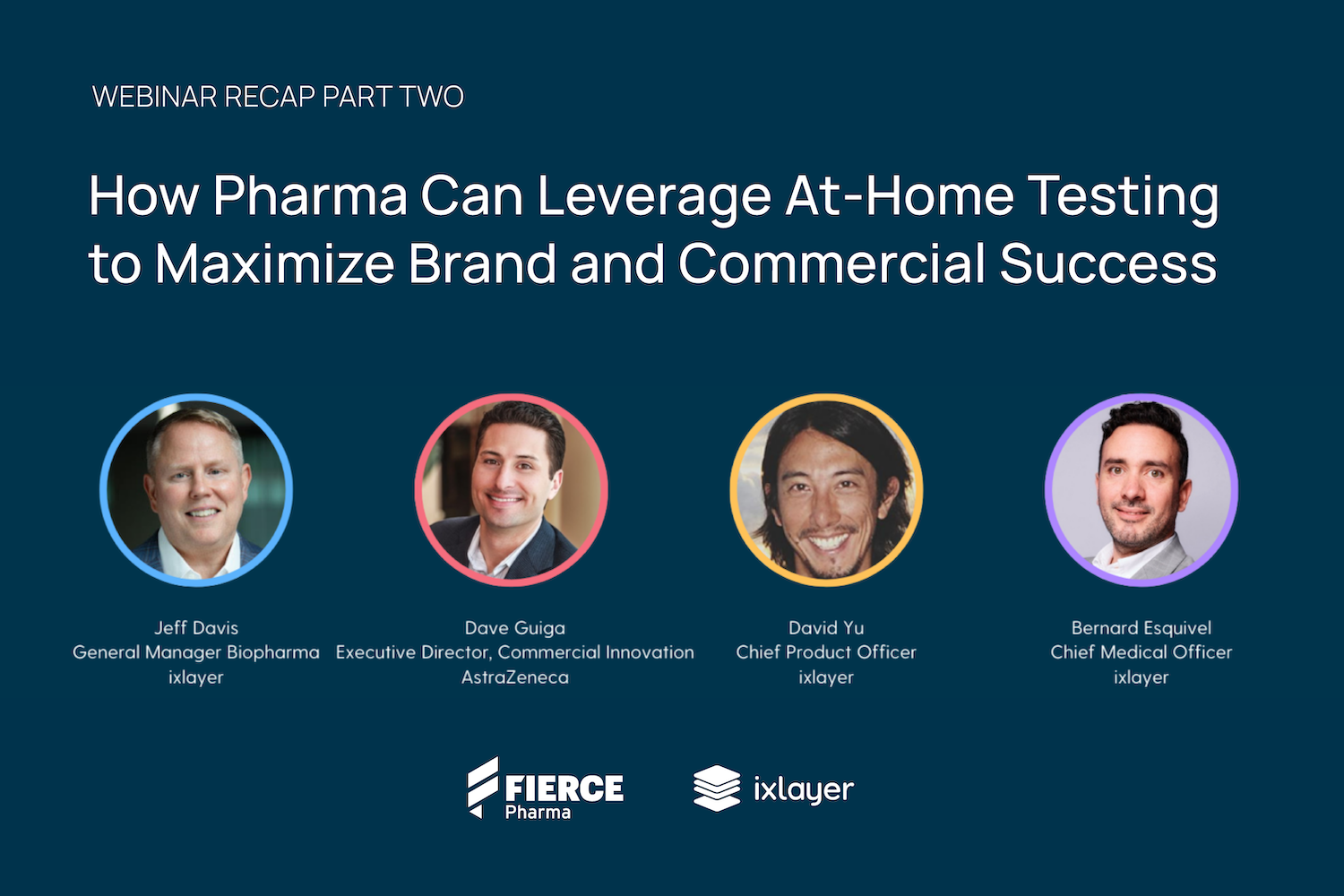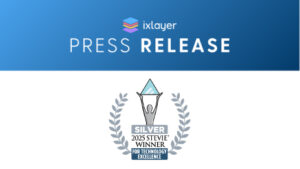Key Takeaways from How Pharma Can Leverage At-Home Testing to Maximize Brand and Commercial Success
ixlayer’s recent webinar, How Pharma Can Leverage At-Home Testing to Maximize Brand and Commercial Success, shed light on the transformative changes sweeping through the healthcare sector, particularly focusing on the rise of at-home testing, biopharma support, and telehealth. This shift, driven by technological advancements and changing patient behaviors, is not just an evolution but potentially a revolution in how healthcare services are delivered and consumed.
Below, is the second part of our recap of the key takeaways from the webinar.
Key Takeaway #4 – Meet patients where they are
David Yu, Chief Product Officer at ixlayer and the third panelist on the webinar, emphasized the importance of meeting patients where they are. The goal of direct-to-patient platforms is to offer multiple options for healthcare delivery, whether through telehealth services or at-home testing kits. This approach ensures that healthcare services are accessible and convenient for all patients, regardless of their circumstances.
“It provides options,” Yu said. “Whether that’s being able to provide telehealth services for common conditions so it’s convenient for patients to meet with their healthcare provider, or taking some diagnostic activities outside of the doctor’s office and into the home, we offer these additional modalities to meet patients where they are.”
The consumerization of healthcare products means that patients now expect a user experience similar to other consumer products. They are no longer willing to tolerate outdated interfaces and cumbersome processes. Companies like ixayer are focusing on creating intuitive, user-friendly platforms that provide clear and actionable information.
Yu said, “We want to make things as simple as possible for people to use. We’re laser focused on providing a great patient experience. But I think the question is, What does that mean? What is a great patient experience? People are no longer putting up with an EHR interface that feels like it’s out of 2002. If you look at some of the great direct-to-consumer products that folks are building out there—from Ro, from hims—they’re as easy to use as ordering a pizza over DoorDash. And the expectation is just so much higher for patients. So when we think about the user experience, there’s a certain bar that is getting elevated every single year that we’re trying to meet when it comes to building new patient products.”
Key Takeaway #5 – Improve patient outcomes
Timely diagnosis and treatment are critical, particularly for chronic conditions like type 2 diabetes or cancer. Delayed treatment can significantly increase the risk of severe outcomes. At-home testing enables earlier detection and intervention, which can improve health outcomes and reduce the burden on the healthcare system.
Dr. Esquivel told the panel that “Seventy-plus percent of medical decisions are made following a laboratory test. So using cancer as an example, if you delay treatment, or access to treatment, by four weeks you increase up to 13% the risk of death for that patient. Access and time matter.”
At-home testing empowers patients to take control of their health. With easy access to testing and clear, actionable results, patients can make informed decisions about their healthcare. This empowerment leads to greater engagement and adherence to treatment plans, ultimately improving overall health outcomes.
David Yu weighed in on how ixlayer’s solution design contributes here, telling the panel that “Giving patients easy access to these user experiences is obviously very important, but the other aspect is enriching that experience. Right now, nine times out of ten, if you go to get tested in a doctor’s office or national lab, usually you just get a PDF back with a bunch of numbers on it. It’s not a very informative experience. What we’ve built at ixlayer is an enriched patient engagement experience where you not only get the results of the test, but some educational material about why you were tested, what these numbers actually mean and what you should be doing. That drives patient activation.”
Yu continued, “Having you get screened and referring you to your PCP, being able to provide some basic instructions on next steps, being able to connect you with specialists—that’s a big part of the platform and the user experience that we’re building into our platform.”
Building on these comments, Dave Guiga added, “It takes a lot of the churn out of the traditional end-to-end kind of journey when it comes to diagnostic testing. And I think that’s great, because ultimately patients are going to wind up getting to diagnosis and treatment quicker compared to the model today.”
Key Takeaway #6 – Stay compliant
Whenever a biopharma organization is bringing a program to market that uses new modalities like at-home diagnostic testing, connection to care through telehealth, or other patient-initiated innovations, it’s critical to bring compliance considerations into the conversation early and ensure they’re a primary focus.
Dave Guiga said, “These programs should not be seen as typical marketing initiatives carried out by a brand team. These programs are significantly different from marketing activities and should not be regarded as a way to simply feed into a customer relationship management (CRM) program. The focus is on making sure that everyone understands the significant importance of data security, especially given the presence of sensitive HIPAA-related information.”
“Hearing Dave articulate that is really enlightening,” David Yu chimed in. “Because those are the important things that our customers think about. Data privacy, data governance—these are the first things we bring up when we’re working with customers and trying to understand how we should be quarantining data, how we need to provide de-identified data and how we should even be exchanging data at all.”
David Yu went on, “We are HiTrust and SoC2 compliant and we’ve invested a lot of time and energy to get there with our core product roadmap. We thought these were the right investments to make if we’re going to be working in this space.”
Dr. Esquivel added a clinician’s perspective on compliance saying, “It’s important that whatever we’re bringing to both the patients and the providers it’s aligned with best practice standards and that it’s actionable. It needs to have clinical actionability. I need to be able to trigger a decision based on that.”
Final Thoughts
In closing, Dave Guiga emphasized the significance of the emerging direct-to-consumer models in the industry, which are enabled by advancements in direct-to-consumer screeners and diagnostics. He highlighted that most clinical decisions, such as determining the appropriate medication for a patient, rely on diagnostic tests. Furthermore, he noted that these programs primarily aim to help patients who may not have had access to certain interventions otherwise.
The ixlayer webinar highlighted the significant shift towards at-home testing and telehealth services, driven by technological advancements and changing consumer behaviors. This transformation holds the potential to revolutionize healthcare delivery, making it more accessible, convenient, and patient-centric. As we navigate this evolving landscape, it is essential to focus on maintaining high standards of quality and accuracy, educating stakeholders, and continuously improving the patient experience. This approach will ensure that the benefits of these innovations are fully realized, ultimately leading to better health outcomes for all.
CLICK HERE to learn more about how ixlayer works with biopharma leaders to integrate a complete end-to-end, direct-to-patient experience into their marketing campaigns.
About ixlayer
ixlayer is the only end-to-end, direct-to-patient platform built for biopharma and optimized for patient choice. We help biopharma companies connect with patients from testing to treatment with speed, transparency, control and impact.




